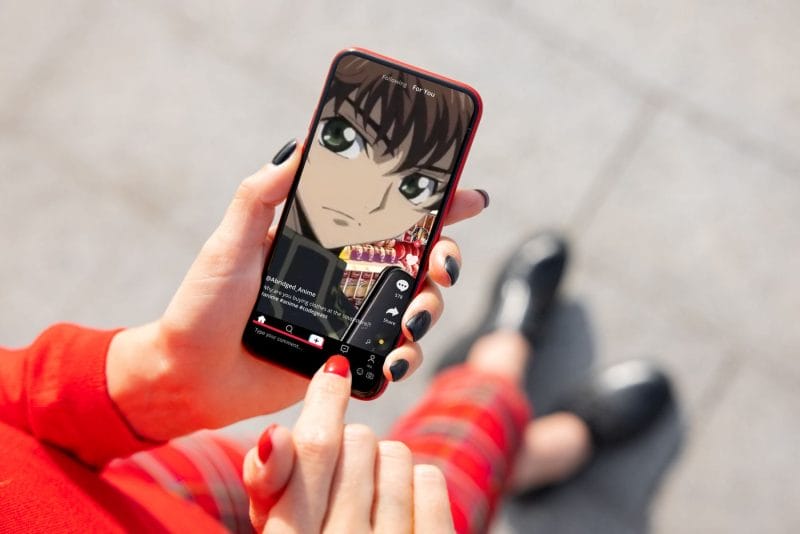Content Warning: Some of the sources linked to in this article may lead to art that is considered Not Safe For Work by common North American standards, and some of the videos you may find of Tanaami’s work include strobes, flashes, audio played backwards, and other neurologically demanding stimuli. Much of that content has eroticism as well.
If you wish to view a Safe For Work example of Tanaami’s animations, follow the link to Adventures in Beauty Wonderland. While it is one of his less strobe-y animations, those with neurological impairments may want to proceed with caution.
Keiichi Tanaami. Have you ever heard of him? Possibly yes, maybe no? Don’t worry if you haven’t; you’re more likely to find his name in a late-night Google search for Elvis Presley than on a listicle that claims to settle, once and for all, “Anime’s Top Nine Greatest Influences.” As far as American fandom is concerned, his name doesn’t fit alongside Osamu Tezuka (Astro Boy), Hayao Miyazaki (Kiki’s Delivery Service), or Isao Takahata (Grave of the Fireflies). Yet his art has graced the albums of legendary bands (The Monkees); helped realize the ongoing Neo-Dadaist movement; and, my dear perverts, he has helped to push the envelope that resulted in fandom’s favorite breasts being drawn with anti-gravity among other supernatural feats. So why the mum? Sure, the deeply trippy Good-bye Elvis and USA is difficult to parse…but that’s the case with many historically grounded artforms. Considering his international renown, there must be more.
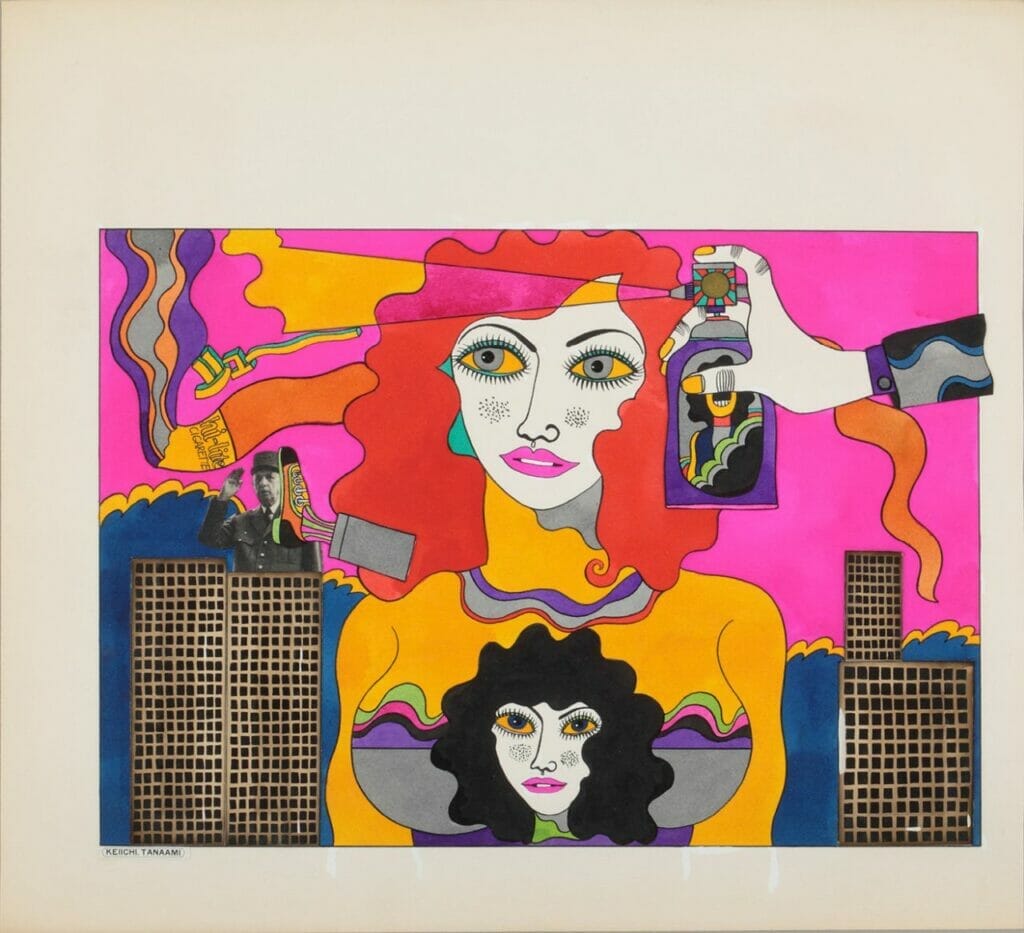
One possible reason could be that few in the English-speaking fandom would even recognize his animations as ‘anime’ at all, and in a region where a creator’s history, nationality, and intended audience are frequently overlooked to the point of calling American-created shows ‘anime’ simply because they appear similar, it’s no wonder. There’s a reason we try to distinguish in this language. But the Japanese definition is a bit more complex, and if you look at Tanaami’s works, you may begin to see how, and why, he influences pop culture to this day.
Tanaami, a professor at the Kyoto University of the Arts, was nine years old when bombs rained down during the Great Tokyo Air Raid in World War II. This hellish experience would go on to inform the recurring motifs in his work, which from the 1970s have delighted the imaginations of people around the world.
In his biography, Tanaami says, “There is no doubt that fear and apprehension along with anger and resignation surged through my dreams, in which the enigmatic monster of war chased down my boyhood, [which I] spent eating and playing to my heart’s content. As I recall, one night during an air raid, I watched a fleeing mob of people from atop a hill. But, I wonder about this. I wonder if it actually happened. Dreams and reality are all jumbled up in my memories, stored in my mind in that ambiguous state.”

Maybe that’s why he was drawn to one of the most noteworthy art movements in postwar Japan: Neo-Dadaism. As the original Dadaist movement came about after the extreme violence of World War I, it comes as no surprise that its successor attracted Tanaami.
“In the 1960s, events that traversed and intersected many diverse genres took place regularly at the Sōgetsu Art Center in Akasaka. Happenings staged by Yoko Ono, videos by Nam June Paik, and experimental American films hit the stage one after the next. The Sōgetsu Art Center was truly the ‘shrine’ of the avant-garde. For the young artists searching for ‘new forms of expression’ at the time, each one of those activities was inspiring.”
Also inspired by his love of movement and juxtaposing colors—not to mention his adoration for Osamu Tezuka—Tanaami solicited Yōji Kuri’s Experimental Animation Studio to help him create Marionettes in Masks.
“It was the first studio I saw in person,” he said. “At the animation stand, we looked over the frame tables I had spent all night drawing up and then started shooting. Every day was an uphill battle, as I had no comprehension of any filmmaking terminology or technique, not even the 24 frame-per-second timing or the movement of the pictures to go along with that; overlapping; shooting frames; fading in and out; and so on. Up until that point, my everyday work had almost exclusively dealt with still images, and still unable to fully grasp that sense of time, filming came to an abrupt end.”
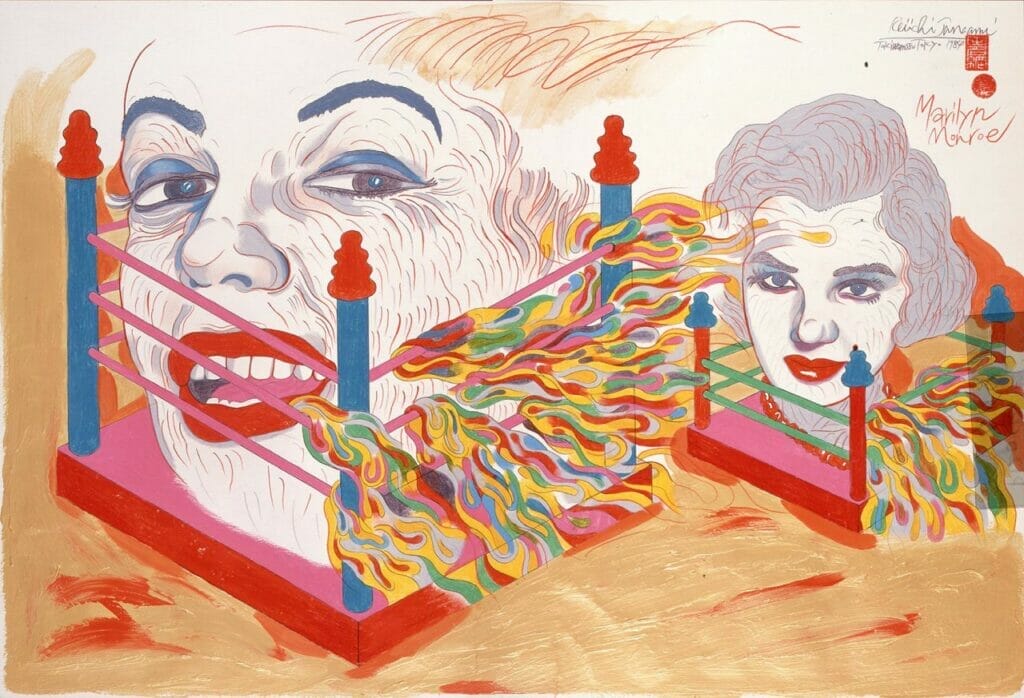
Yet he loved the process and went on to create some extremely psychedelic and erotically charged animations for the time, including Good-bye Marilyn, Good-bye Elvis and USA, Sweet Friday, and The Bride Stripped Bare By Her Bachelors.
His work was so distinctive that he was commissioned to paint cover art for bands like Jefferson Airplane and The Monkees, as well as erotic paintings of 1970s Hollywood stars. His work caught the eyes of many overseas, including the staff of Playboy Magazine. In 1975, when Shueisha brought Monthly Playboy to Japan—yes the publishers of Shonen Jump also published Playboy—he became the first art director for the magazine.
In the first chapter of The History of Hentai Manga, Kimi Rito attributes the “influence export of foreign gravure magazines” as one of the reasons mangaka began drawing larger breasts in the 1970s and 80s. Tanaami’s bold erotic works were part of this movement as well, reaching beyond what was then a niche market into broader pop cultural art.
On social media, the resurgence of the Dadaist movement is sometimes given credit for today’s meme culture— though it’s worth noting at least one thoughtful refutation of that claim. The mediums do share some things in common, though, which could be where the association comes from.
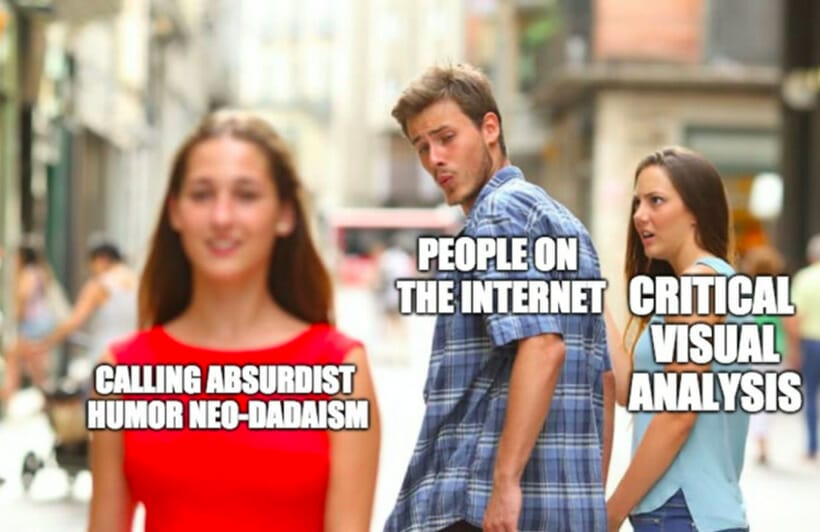
In his 2015 article for Widewalls Magazine, Bob Lansroth describes Neo-Dada’s “abundance of unorthodox materials, everyday objects and unusual mediums” as being “turned into a shared public language.” This certainly sounds like the case for memes, many of which combine mundane references with profound absurdism and then run wild on the internet.
Both mediums are also highly situated in daily life — you sort of have to be there to get it right away. They’re frequently anti-consumer, or at least complicated-consumer, and in both mediums the viewer’s interpretation matters more than artistic intent. But when describing Neo-Dada, Lansroth goes on to say, “It inspires the viewer to ignore the traditional aesthetic standards, forget the pre-conceived notions and address the art with critical thinking.”
This is an interesting distinction. While memes exist to provoke and supply a quick reaction, relatively speaking—and many are very clever in their absurdism to do exactly this—Neo-Dada thrives on flooding viewers with such familiar sensations that, when combined just right, they’re perceived as nonsensical to the point of being wholly unexpected. Intensely flummoxed, the viewer must slow down, analyze the piece and carefully think, what in the world did I just watch?
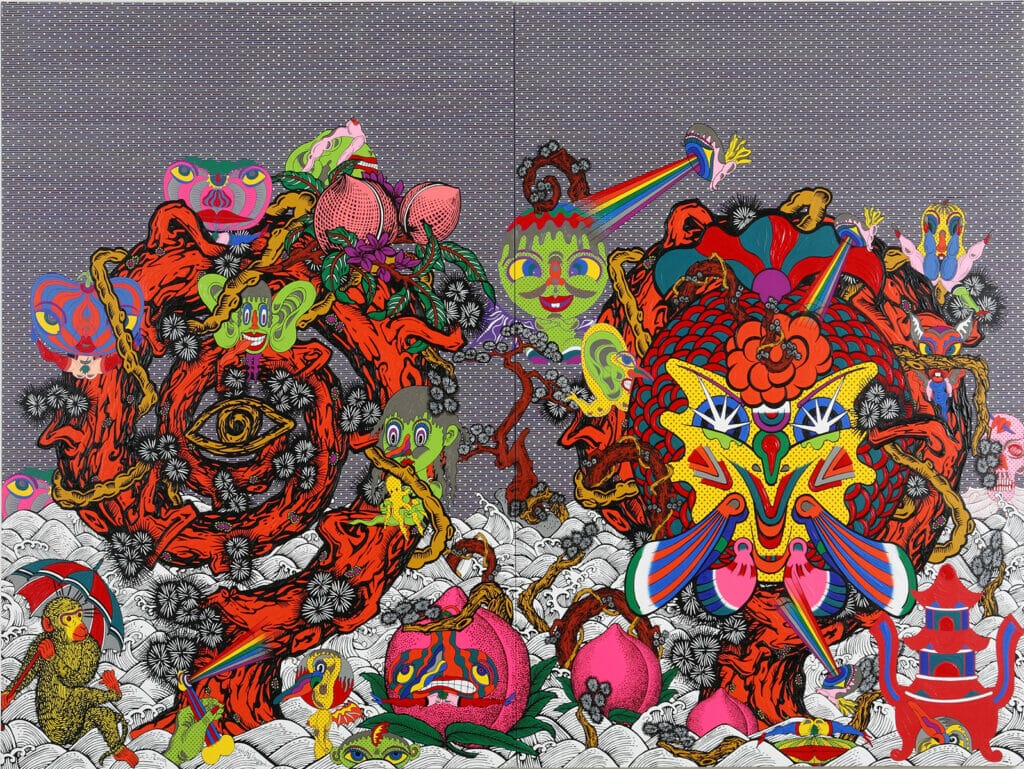
In this light, we begin to see how Tanaami’s childhood experiences had begun to shape his self-expression, and as a result, his most remarkable pieces. Writing for Tate in 2015, Lina Džuverović described Crayon Angel in kaleidoscopic terms:
“Opening with the sound of sirens and dramatic drumming over images of fighter jets and explosions, the fast-paced video goes on to combine black and white photographs of Japanese families and children, often seen through black prison-like bars which recall Japanese fusuma (sliding doors used to partition spaces within a room), with psychedelic characters and superheroes appearing on traditional Japanese patterns. The incongruity of such imagery points to Japan’s difficult past, its growing consumerism and the pervasive nature of global pop culture.”
Yet fear doesn’t seem to be present in most of Tanaami’s works – even those dealing with invasions and war. In a fascinating interview with Azito, he details why.
“I was quite little (9 years old) during the war. It was a hard time – there was no food, nothing to see. And there were air attacks everyday. I think I wasn’t afraid since I was too little. However, I could understand that things weren’t normal by seeing my mother’s behavior. I sensed the situation by seeing adults around me but not directly from the war itself. I didn’t feel impending fear of dying by a bomb.”
Instead, he describes a profound sense of boredom and the subsequent joy he felt when witnessing a small wonder of nature.
“I was in a bomb shelter and had nothing to do…For a kid, it was really boring. Then, when the bombs fell nearby, its heat was hot as if your face is burning. My mother kept putting a wet towel on me to relieve the heat…I was very tired, but I couldn’t sleep. In that situation, just seeing goldfish swimming in a tank was a real pleasure for me. Flare bombs fell down and their lights were reflected on the goldfish’s scales. It was like watching a movie and it was quite fun. So it is not related to my tragic memory but more to a delightful moment.
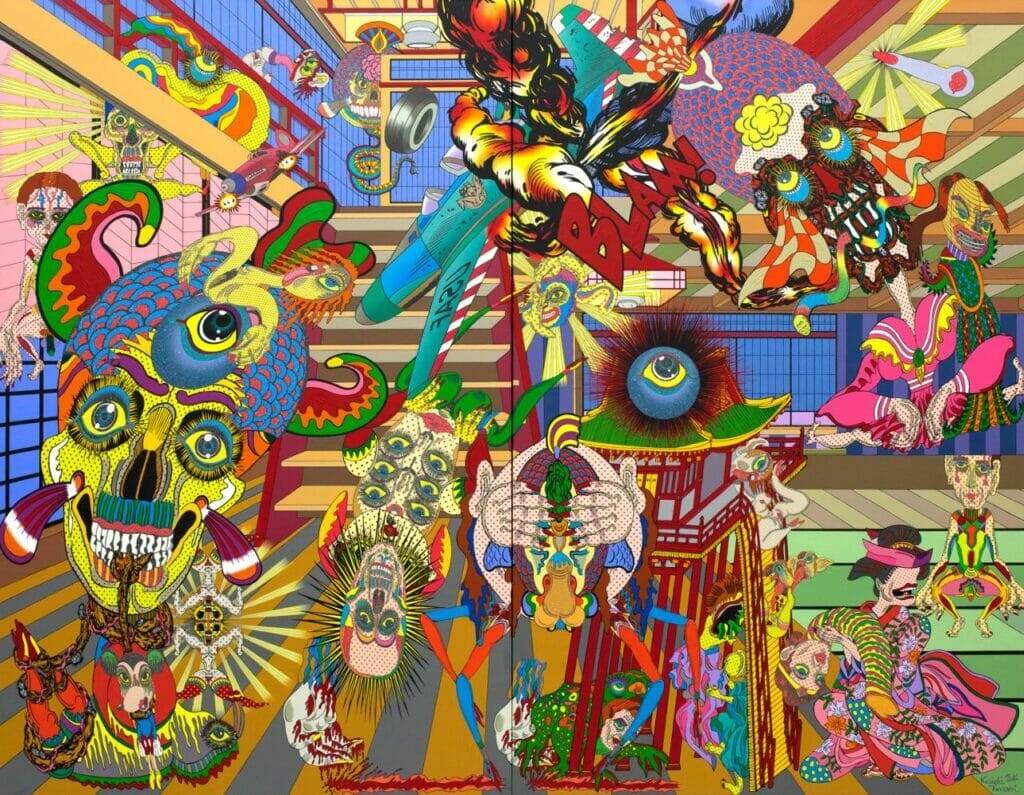
And I think, under that kind of tragic situation, people can’t get through it if one cannot find something enjoyable. I think human beings are well-created to behave like that so that they can escape from those mental horrors.”
Tanaami continues to feature these ‘somethings’ in each of his compositions, accumulating new motifs with every decade he experiences. Adventures in Beauty Wonderland, commissioned by Sephora in 2013, blends old with new in the overarching hand of a person who has witnessed the accelerating globalization of the past eighty years. Taking inspiration from big names and small, Tanaami even began experimenting with Picasso during the COVID-19 pandemic, and as his job with Sephora showed, he’s always ready to return to his commercial roots with a dose of Neo-Dadaist critique.
We can only imagine the kinds of stories that would exist if Tanaami had decided to focus on anime after all.
“My life is not a straight shot,” he said in his biography, “with one central theme running through it like a book. It would be more properly called a ‘magazine editor’s life’, spent looking about at my surroundings constantly, wandering from place to place, engaging in a wide variety of work along the way.”
With all the mediums he’s tried his hand at, perhaps we’ll see manga in the future – and what a fun ride it would be.












